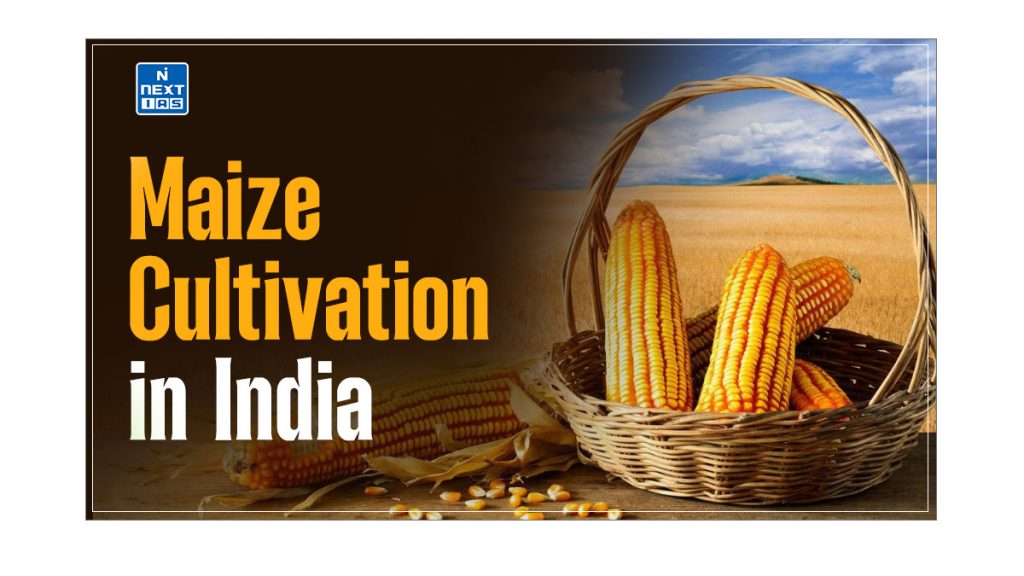
Maize, often referred to as Indian corn, is prominent in Indian agriculture due to its adaptability and economic significance. Its cultivation spans various regions across the country, impacting both agricultural productivity and industrial development. This article aims to study in detail the multifaceted economic and social impacts of maize cultivation, highlighting its contributions to agriculture, industry, and rural livelihoods.
About Maize
- Maize, often known as Indian corn, is globally called the queen of cereals due to its highest genetic yield potential.
- In India, it is the third most important food crop after rice and wheat. Maize serves multiple purposes: it is used as both food and fodder.
- Besides being a staple food for humans and a quality feed for animals, maize is a crucial raw material and ingredient in various industrial products, including starch, oil, protein, alcoholic beverages, food sweeteners, pharmaceuticals, cosmetics, film, textiles, gum, packaging, and paper industries.
Conditions for Growth of Maize
- Maize is a rainfed Kharif crop primarily grown in regions with semi-arid conditions (25 – 75 cm rainfall), where rice and wheat production is not feasible.
- It cannot be cultivated in areas with more than 100 cm of rainfall.
- In Tamil Nadu, maize is a rabi crop sown before the onset of the winter rainy season in September and October, as rains occur mostly in November and December in eastern Tamil Nadu.
- Maize can be grown in various soils, from loamy sand to clay loam.
- However, soils with good organic matter content, high water holding capacity, and neutral pH are ideal for higher productivity.
- Well-drained and fertile loams free from coarse materials and rich in nitrogen are optimal for maize cultivation.
- Being sensitive to soil moisture and salinity stresses, low-lying fields with poor drainage and higher salinity should be avoided.
- The maize cultivation in India often includes inter-culture practices with pulses, vegetables, and oil seeds.
Distribution of Maize in India
- Maize is cultivated throughout the year in all states of the country for various purposes, including grain, fodder, green cobs, sweet corn, baby corn, and popcorn in peri-urban areas.
- The predominant maize-growing states are Karnataka, Madhya Pradesh, Maharashtra, Andhra Pradesh, Rajasthan, Bihar, and Uttar Pradesh.
- Maize has emerged as an important crop in non-traditional regions, such as peninsular Indian states like Karnataka and Andhra Pradesh, which have recorded some of the highest production and productivity in the country.
Maize Producing States in India
- Karnataka – It is the leading maize producer with substantial production volumes. It has exceptionally high yields in the southern and central parts.
- Madhya Pradesh – It is an important maize-growing state with significant contributions to national production. It is mainly grown in the central and eastern districts.
- Maharashtra – It has a major maize-producing area with diverse cultivation practices. It has prominent production in the Vidarbha and Marathwada regions.
- Andhra Pradesh – It has high production levels, especially in the southeastern part of the state. It has notable production in districts like Chittoor and Anantapur.
- Rajasthan – Its maize production is increasing, particularly in arid and semi-arid areas. Its cultivation is notable in the southwestern and southeastern parts.
- Bihar – It has significant maize production that contributes to the eastern region. The key areas include the northern and central districts.
- Uttar Pradesh – It is a major maize producer that is substantially grown in the northern plains. It has prominent production in districts like Gorakhpur and Kanpur.
- Peninsular States – Karnataka and Andhra Pradesh are notable for high production and productivity in non-traditional areas.
Economic and Social Importance of Maize Cultivation
Economic Importance
- Contribution to Agriculture – Maize is a vital crop in Indian agriculture, contributing significantly to the country’s agricultural output.
- Its versatility allows it to be grown in various climatic conditions and soils, enhancing its economic value.
- Industry Integration – Beyond its role as a staple food and fodder, maize is a crucial raw material in several industrial sectors.
- It is used to produce starch, oil, protein, and various food products, including sweeteners and alcoholic beverages.
- The maize industry supports numerous downstream sectors like textiles, pharmaceuticals, and packaging.
Social Importance
- Employment – Maize cultivation employs many people, especially in rural areas.
- It supports agricultural labourers, farm workers, and those involved in processing and transportation.
- Livelihood – For many farmers, maize is a primary source of income. Its cultivation is critical in regions where other crops might not be as viable due to climatic conditions.
- Maize cultivation provides economic stability, which helps improve the standard of living for farming communities and contributes to rural development.
Conclusion
Maize cultivation is a cornerstone of Indian agriculture, driving both economic growth and social development. Its role extends beyond being a staple food to serving as a vital raw material for various industries. The employment opportunities it generates and its contribution to farmers’ livelihoods underscore its importance in enhancing rural economies. As maize continues to be a key crop, the economic and social benefits of maize cultivation will remain integral to India’s agricultural landscape and rural prosperity.
Frequently Asked Questions (FAQs)
What is the process of maize cultivation?
Maize cultivation involves selecting fertile, well-drained soil, planting seeds in rows, and providing consistent moisture and nutrients. Weeds and pests are managed, and harvesting occurs when kernels are mature and dry.
What are the best-growing conditions for maize?
Maize grows best in warm climates with temperatures between 60-86°F (15-30°C) and requires full sunlight. It thrives in well-drained, fertile soil with a pH of 5.8-7.0 and needs consistent moisture throughout its growing season.





